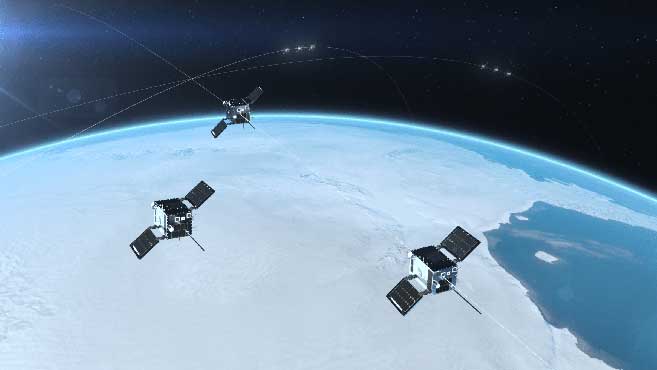Three HawkEye 360 Formation-Flying Microsatellites Built By Space Flight Laboratory (SFL) Successfully Launched

TORONTO, Ontario, Canada, 1 July 2021 – HawkEye 360 Inc. announced the successful launch of its Cluster 3 radio frequency geolocation microsatellites built by Space Flight Laboratory (SFL). Carried aboard the June 30 SpaceX Transporter 2 mission, the Cluster 3 formation-flying microsatellites join in orbit the HawkEye 360 Cluster 2 and Cluster 1 Pathfinder satellites – all built by SFL.
The HawkEye 360 launch brings to 20 the total number of SFL satellites placed into orbit in less than a year. The Cluster 3 satellites were built on SFL’s space-proven 30-kg DEFIANT microsatellite bus.
“SFL congratulates HawkEye 360 on developing the world’s first commercial satellite constellation for radio frequency (RF) signal intelligence,” said SFL Director Dr. Robert E. Zee. “Contact has been made with all three Cluster 3 microsatellites. They are healthy and undergoing commissioning.”
The HawkEye 360 Constellation detects and geolocates RF signals for maritime situational awareness, emergency response, national security, and spectrum analysis applications. Cluster 3 significantly expands HawkEye 360’s global revisit and collection capacity, stated the Herndon, Va., company.
HawkEye 360 selected SFL due to the importance of formation flying by multiple satellites for successful RF geolocation. SFL is the acknowledged leader in developing and implementing high-performance attitude control systems that make it possible for relatively low-cost nanosatellites and microsatellites to fly in stable formations while in orbit.
The previous HawkEye 360 satellite clusters built by SFL were the Pathfinder launched in 2018 and Cluster 2 in January 2021. Each Cluster is comprised of three satellites.
Other launches of SFL-built satellites in just the past year include missions developed for the Norwegian Space Agency (NOSA) in Norway, the Dubai-based Mohammed Bin Rashid Space Centre (MBRSC) in the United Arab Emirates, GHGSat Inc. of Canada, Space-SI of Slovenia, and a Canada-based telecommunications company.
SFL is a unique microspace provider that offers a complete suite of nano-, micro- and small satellites – including high-performance, low-cost CubeSats – that satisfy a broad range of mission types from 3 to 500 kilograms. SFL’s heritage of on-orbit successes includes 72 satellites and distinct missions related to Earth observation, atmospheric monitoring, ship tracking, communication, technology demonstration, space astronomy, solar physics, space plasma, and other scientific research.
Since 1998, SFL has developed CubeSats, nanosatellites, and microsatellites that have achieved more than 150 cumulative years of operation in orbit. These microspace missions have included SFL’s trusted attitude control and, in some cases, formation-flying capabilities. Other core SFL-developed components include modular (scalable) power systems, onboard radios, flight computers, and control software.
About Space Flight Laboratory (SFL)
SFL generates bigger returns from smaller, lower cost satellites. Small satellites built by SFL consistently push the performance envelope and disrupt the traditional cost paradigm. Satellites are built with advanced power systems, stringent attitude control and high-volume data capacity that are striking relative to the budget. SFL arranges launches globally and maintains a mission control center accessing ground stations worldwide. The pioneering and barrier-breaking work of SFL is a key enabler to tomorrow’s cost aggressive satellite constellations.
Download the specification sheet for all SFL platforms here.
SFL Contact:
Dr. Robert E. Zee
SFL Director
1-416-667-7400
info@utias-sfl.net
Follow SFL on Twitter @SFL_SmallerSats
